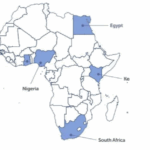Home to a burgeoning tech ecosystem, Africa has seen the rise of numerous innovative start-ups, ranging from finance to leisure industries. Recently, 30 tech start-ups were selected to showcase their products and services at the noteworthy Demo Africa event, underscoring the continent’s remarkable progress in innovation and economic growth. However, the spread and adoption of these technology-based start-ups remain highly uneven with Nigeria and Kenya leading the pack, while South Africa trails behind.
Still, there’s one category that’s gaining significant attention across the continent: traffic apps. They have surfaced as a crucial tool in navigating the congested roads of African cities, particularly in Nigeria and Kenya. Let’s delve into these traffic apps and examine their impact from the Nigerian and Kenyan perspectives.
A quick glance at the economic impact of traffic jams reveals the imperative need for such apps. Nairobi, for example, reportedly loses over $350 million annually in fuel consumption and lost productivity through long man-hours spent in traffic. In Lagos, the figure is even higher, at about $663 million. Faced with similar circumstances, major cities across Africa are now turning towards technological solutions to combat this problem. Enter the traffic apps.
In Kenya, Ma3Route and Waze have emerged as the primary go-to apps for traffic updates. These apps provide live traffic reports based on user-contributed information. Ma3Route was founded in 2012 by Laban Okune and now boasts a 300,000 user-strong community. Waze, on the other hand, is a collaboration between Kenya’s biggest Telecom company Safaricom and tech giant Google. Despite having a powerful backer, Waze still falls short of Ma3Route in terms of user base.
Lagos has seen similar developments with apps like GidiTraffic and Traffic Butter making regular travel easier through crowdsourced traffic updates. Interestingly, Tsaboin steps up the game by offering users not just text updates but also allowing them to see live traffic situations for a small fee.
A question then beckons – how do these apps generate revenue when providing largely free services? Some, like Ma3Route, charge a fee for users to receive updates via SMS. Others, like GidiTraffic, may leverage their community strength for crowd funding or opt for ad placements.
A promising future avenue for these traffic apps lies in collaboration with ride-hailing services like Uber. By integrating their traffic feeds into Uber’s system, drivers can use the best possible route to reach passengers. An arrangement of this kind could significantly enhance Uber’s service efficiency.
Looking ahead, traffic apps might follow in the footsteps of Waze, which joined hands with Google to display live traffic situations on its route mapping. By exploring partnerships like these, traffic apps can leverage smartphone mapping services to provide more accurate data.
In sum, as these traffic apps continue to grow and evolve, they offer a promising landscape for easing traffic congestion, improving road safety, and fostering economic productivity in Africa.
This article was updated in 2025 to reflect modern realities.
Discover more from TechBooky
Subscribe to get the latest posts sent to your email.






